I may have discovered the culprit.
The last few times I’ve been out photographing birds I’ve been having a significant problem with soft images. I nearly always photograph in the early morning when it’s quite cold this time of year and I shoot from inside my pickup, using it as a mobile blind. Shooting with a warm lens in cold air is a known cause of sharpness issues but many other things could be responsible too including a malfunctioning camera, lens and/or teleconverter and electrical contacts that need cleaning.
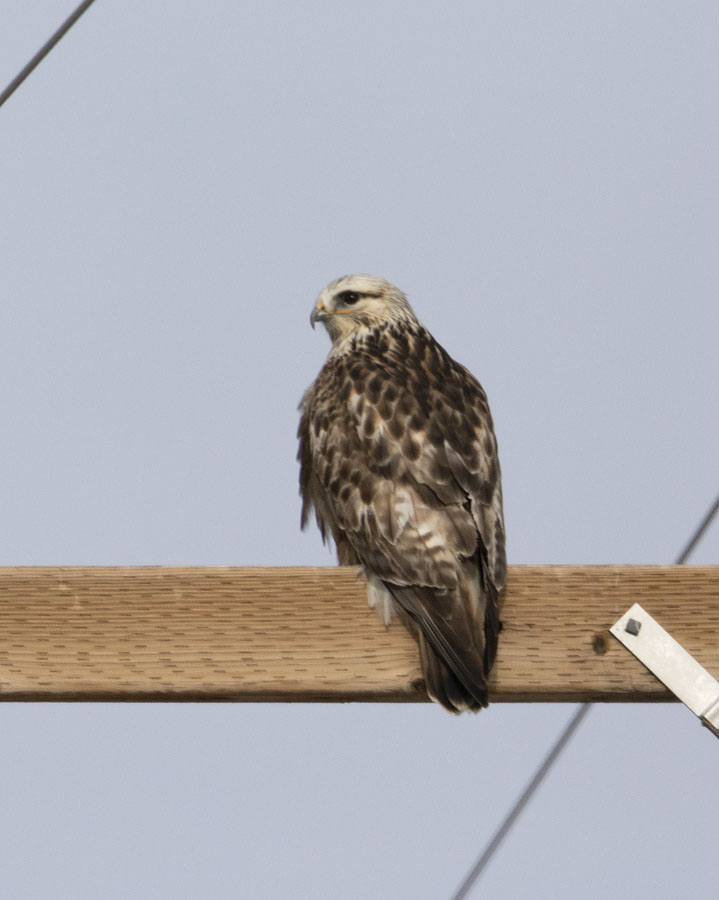
This photo of a Rough-legged Hawk taken five days ago is a typical example of the soft shots I’ve been getting. If I can’t get photos sharper than this one I might as well sell all my camera gear and start looking for the Loch Ness Monster or Sasquatch where I’d probably have a better chance of success and fulfillment.
My 500 f/4 prime lens has a huge lens hood mounted in front of it so there’s a large volume of air trapped inside the hood between my warm lens and the cold outside air. I wondered if turbulence in that trapped air caused by the extreme temperature gradient could be the cause of my soft images so two days ago on an early morning trip to Antelope Island I decided to perform a little experiment.
I removed my lens hood and kept it off for the entire morning.
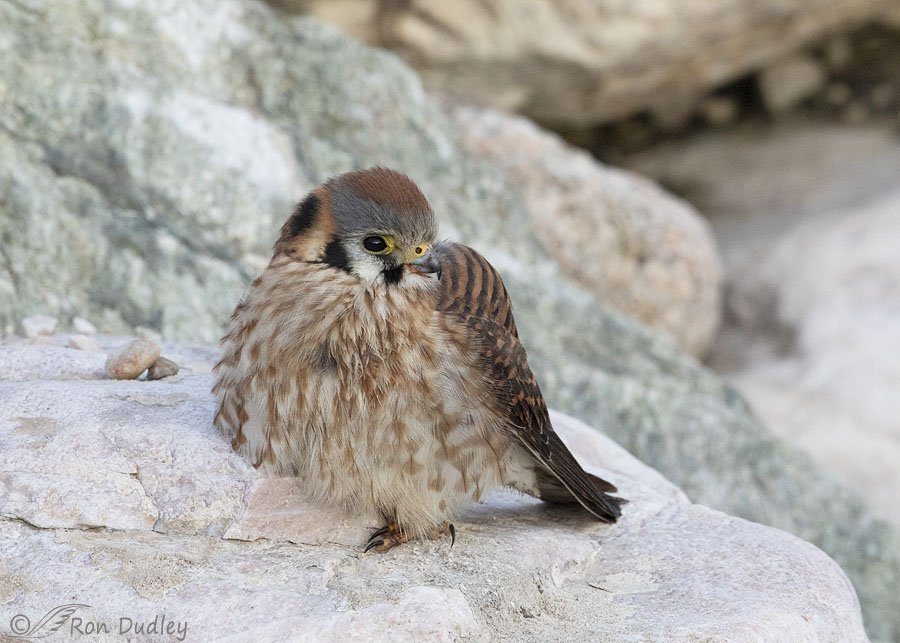
I photographed this female American Kestrel in deep shade only minutes after sunrise when it was still very cold. With my hood removed every photo I took of her was sharp, just like this one.
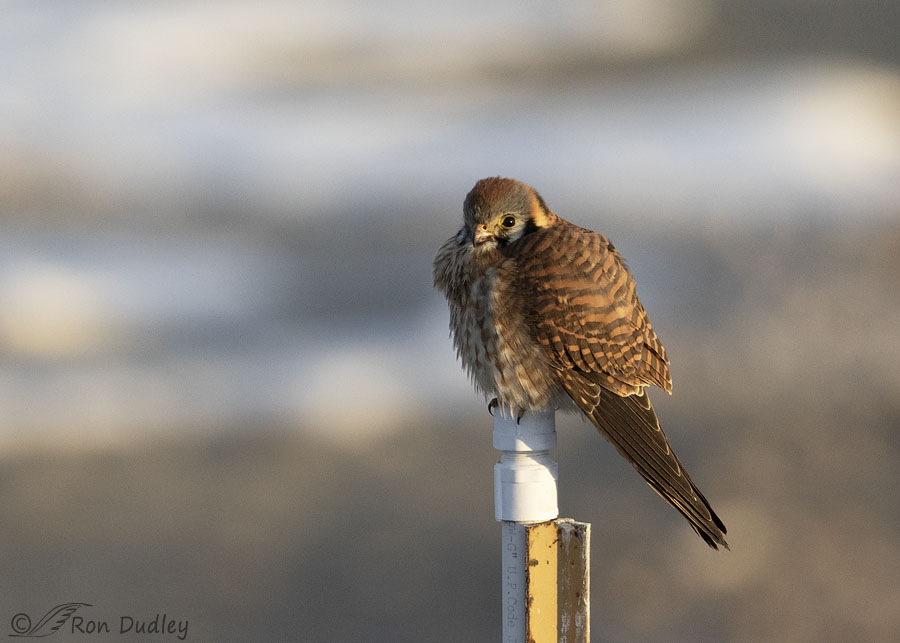
When she flew off to hunt from this ugly perch I took more photos of her just to test for sharpness. She was far away but once again they were all sharp (this photo has been cropped significantly)..
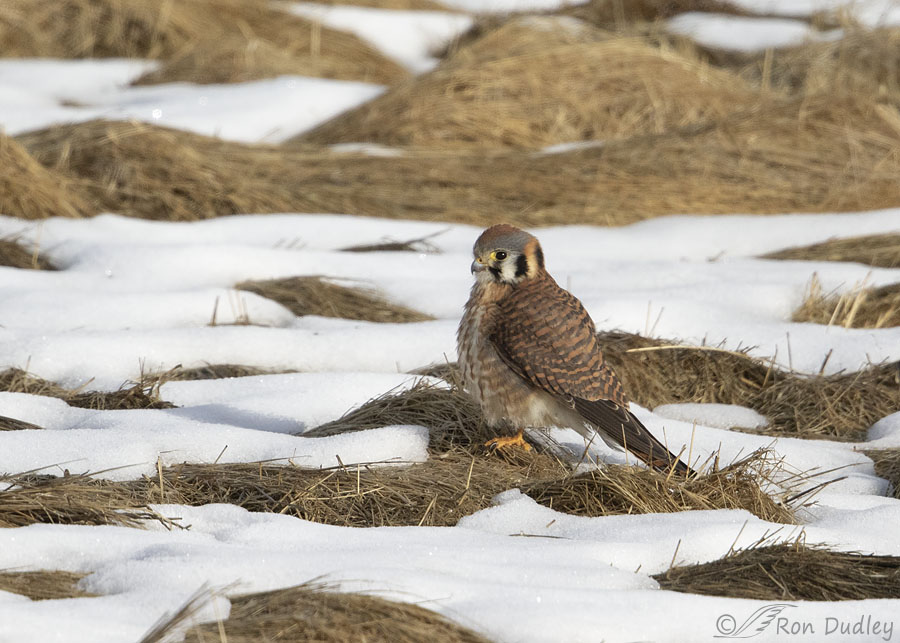
A couple of hours later when I was on my way home I found what was probably the same kestrel in the same general area. She wasn’t close but I took some more test shots and they were plenty sharp. The other photos I took that morning without the hood attached to my lens, including the Horned Lark I posted photos of yesterday, were also sharp.
Was I on to something? Is air turbulence within my hood on cold mornings the cause of my sharpness issues? If so the solution seems obvious and easy – just leave the hood off.
But leaving it off has its own issues.
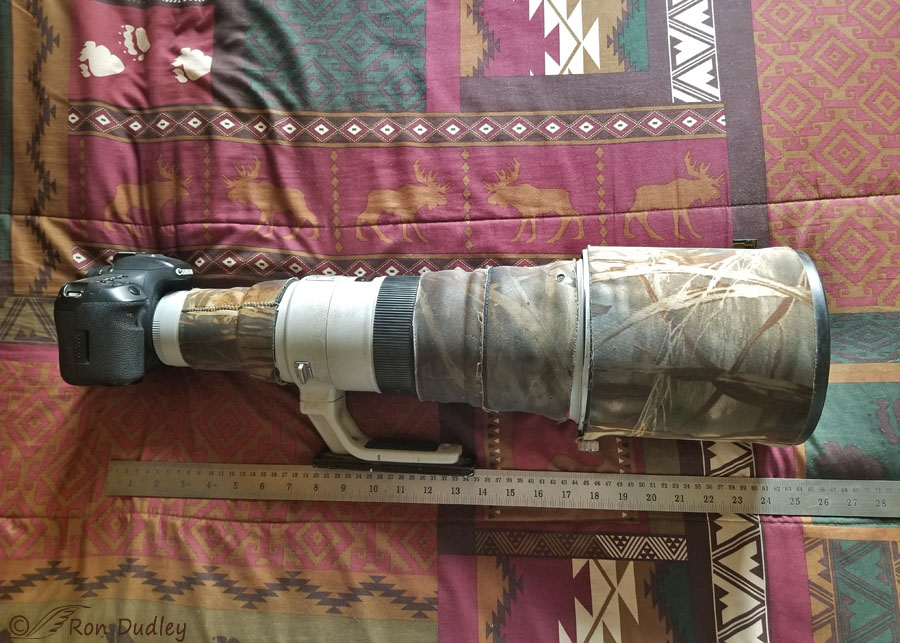
Here’s my camera and lens with the hood attached (yes, my Lens Coat is old, worn and dirty and in need of replacement).
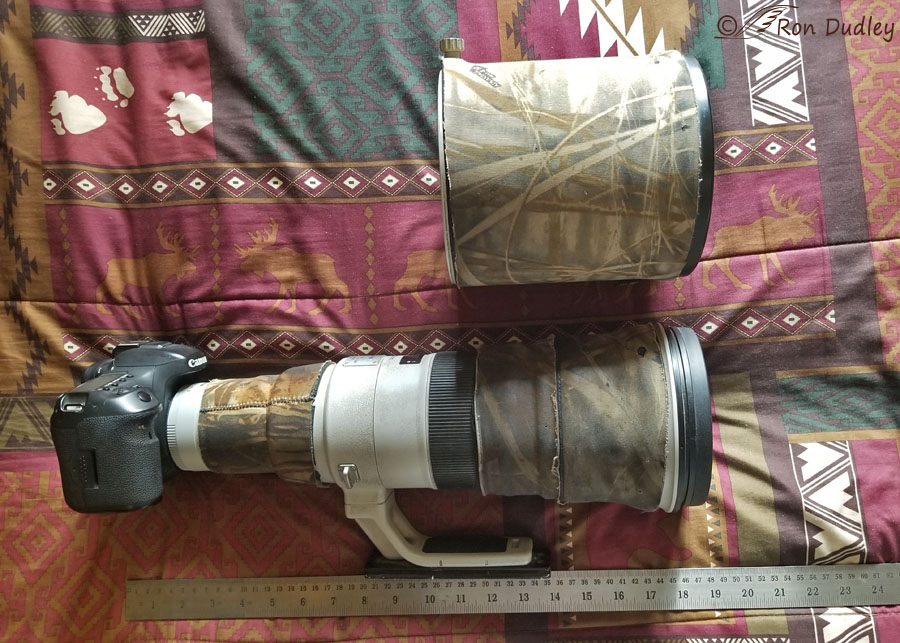
And here’s the entire setup with the hood removed. The hood is huge in both volume and length and adds almost 7″ to the total length of my lens.
As every bird photographer with a long lens knows, aiming the lens quickly and accurately in the field is a critical skill that’s extremely difficult to learn well – especially when you’re trying to photograph birds in flight. It can take years to develop that skill to a high degree. When I first started photographing birds I can’t tell you how many hours I spent practicing on gulls and other common birds in flight. Once it’s learned the muscle memory becomes automatic and accurate – as long as you’re using the same lens!
But if you remove the hood you might as well be using a different lens. Both its length and its diameter change dramatically so your muscle memory is now worse than worthless. Aiming the lens quickly and accurately becomes damn near impossible. Even with the stationary kestrel in the second photo above I had a hell of a time even finding the bird in my viewfinder. It’s no exaggeration to say that I felt l like a rookie bird photographer again.
And when you remove the hood there’s another potential problem that I knew could be such a major disaster just the thought of it that morning on the island had me in a paranoid sweat.
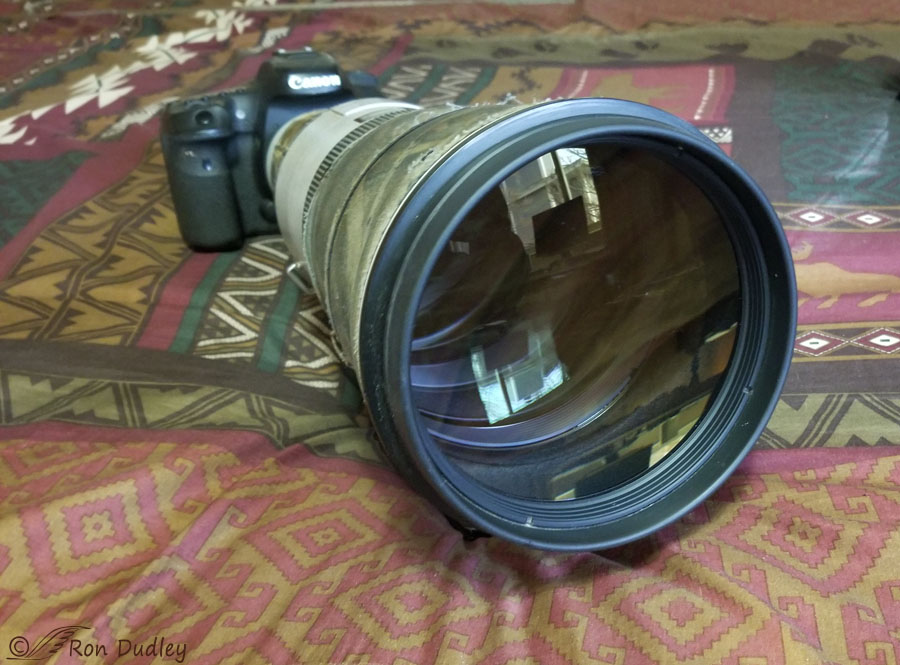
With the hood removed the front element of my lens has lost any protection against scratches. That front element is a very large and very expensive piece of glass and I really don’t want to have to replace it. Lenses like mine will not accept front mounted UV filters to protect the front element so with the hood removed I’m playing a dangerous game.
How much would it cost me to have the front element replaced if it became scratched? I don’t know but if I had to replace my lens hood, which is nothing more than a hollow tube with a tightening knob, it would cost me $640 so replacing the front element couldn’t be cheap. That’s a row I really don’t want to hoe.
So am I now convinced that my soft images when shooting in cold weather are caused by turbulent air trapped inside my lens hood? No, not quite. Becoming convinced will take more testing. Which means more time shooting with my lens hood off and more slow and inaccurate aiming of my lens.
And more paranoia over a potentially scratched front element.
Ron
Notes:
- Another function of the lens hood is to prevent lens flare and glare in certain lighting conditions. So that’s another risk I’ll be taking whenever I remove the hood.
- The hood is as expensive as it is because it’s made out of carbon fiber to save weight. And because Canon can get away with charging such an exorbitant price…


I have the same issue with my Nikon 500 F4 when shooting from the vehicle. My husband is my driver, and now whenever we stop to shoot something, he turns the engine off and within a few seconds of it being off, I can get a sharp shot. But if I shoot with the engine running, it’s a constant battle of soft vs. sharp, most being too soft. I was assuming it was the engine heat drifting up toward the window I’m shooting from. I haven’t tried taking the hood off, but I will try it after reading your experience, because I’d like him to be able to leave the engine on, especially when it’s so cold.
Jai, you’re getting soft shots with the engine running because it causes vibrations. I avoid shooting with the engine running whenever possible, which is nearly always. The softness is made even worse at slower shutter speeds..
Hi Ron…I wouldn’t like to see you sitting in a cold vehicle in order to keep your camera/lens cool to possibly avoid this problem, but have you thought about bringing an ice pack and wrapping your gear in a blanket with the ice pack?
I hadn’t thought of it Pamela but who knows the lengths I’ll be willing to go if I don’t conclusively get this figured out.
I’m a little fuzzy on something perhaps you could clear up. You said you typically shoot from inside your truck. I’m going make the assumption your shooting range has remained fairly consistent over the years. Meaning you didn’t just decide to try your luck in Minnesota in January and encounter conditions you’re not familiar with. So something has changed. Some variable has been introduced into your formula for sharp pictures… Or your autofocus is failing… Or perhaps you’re having an issue with IS?.. Atmospheric disturbance is a real issue with the super-telephoto lens. I’ll set my gear up on it’s gimbal, remove the hood and let all of it acclimate to the conditions. If I get cold I’ll jump back in my truck and leave the camera out. Taking a lens from the 70 degree temp in my truck to sub-zero ambient raises hell with sharpness.
Thomas, yes my shooting habits have remained quite consistent over the years but my problems with soft images in winter certainly have not. They’re unpredictable.
I despise the word “intermittent” whenever it involves problems with vehicles or camera gear.
With my chronic bad back I can’t shoot from a tripod anymore, at least not for very long. Standing that long raises hell with the nerves in my back, legs and feet.
I’ll share a quick story with you. Take from it what you will. Last summer I was having issues with my 800. It simply would not grab focus from time to time. I encountered the problem across three different camera bodies. 5D MK III, 5D MK IV and 7D MK II. The problem was – intermittent. I was so pissed one day I almost tossed it in the river. (Not really but almost) I sent the lens in to CPS. They disassembled it, checked everything out and gave it a clean bill of health. No issues found. My personal opinion? During the disassembly/reassembly process they unknowingly ’fixed’ something. It’s worked perfectly since across all bodies which includes the R5 now.
“I was so pissed one day I almost tossed it in the river.”
Boy, do I understand that feeling!!!
By the way, I had a friend who bought Canon’s 800 mm as soon as it was released. If I remember correctly its price tag was something like $13K, maybe more.
Within days after he bought it he had it on his tripod when it tipped over on concrete, breaking his lens into two completely separate pieces with only wires holding them together.
Talk about heartbreak…
At that point *I* would jump in the river. 😉
I didn’t know the hoods were carbon fiber. My hubby has a carbon fiber cello. It has slightly different dimensions than a wooden one, so there’s definitely a learning curve whenever I play it.
I wish you luck in your continued experiments, wonderful subjects in your viewfinder and no scratches.
Marty, most lens hoods aren’t carbon fiber. For example the hood for my smaller 100-400 zoom lens is just plastic.
Just looking at that giant lens, with or without hood, makes my shoulder ache! But your fabulous photos are worth it … not that I have to suffer for your art. 😬
Fluffy little Kestrel is gorgeous, even if she picked a rather unsightly perch for the second image, which is my favorite.
Chris, that lens can be heavy especially if you’re hiking around with it. But the older version of the same lens, which I used to own, was even heavier.
I hate to even suggest this because it sounds horrible to me, but could you dress even warmer and allow the truck interior to be cooler so that the temperature differential is less?
Ken, if it comes to that I may do it but only as a test. I wouldn’t shoot like that on a day to day basis.
Is it possible you are getting some condensation on the lens with the hood on? Possibly even from your on breathing? I’ve occasionally noticed that when using telescopes on cold nights…particularly on my little refractor scope which–at about the same size is much like your long lens–and has a rather deep (and permanently mounted) “hood” in front of the front glass. Condensation from breathing can sometimes sneak in there. Images are slightly foggy until it evaporates.
Jim, I’ve never had a problem with condensation unless I happen to breathe on my viewfinder when it’s cold but that’s a different issue.
I’m sure that’s largely do to our very low humidity here in the desert.
As a scientific educator yourself, you must be gratified to see that scientific evidence appears to have returned as the national policy. As such I need to see HOHO. Hood on vs. hood off, not the cake.
Same:
subject,
camera,
settings,
photographer
similar, as you say, temperature gradients.
Have I missed anything?
Oh yeah, and no donuts (or HoHo’s) between shots, and a Kestrel like this would be a nice subject.
Lyle, I’ve tried doing that with little to no success so far. Birds often don’t hold still or stay in the same place long enough to get it accomplished and then there’s the issue of missing some potentially great photos during the time I’m swapping out my lens hood.
That’s why I said I need to do more testing.
I am guessing that since it can’t take lens filers it does not have a sliding hood hole like the Canon 100-400 zoom? I leave my sliding door open to try to allow the air to circulate in the cold.
Nope, it doesn’t have that hole, April.
It actually does take filters but they’re mounted toward the rear of the lens, not in front.
Now that was a brave and scary experiment. Its probably success raises whole new issues.
David Harkins’ suggestion makes sense, but I assume that would require more muscle memory training.
Some days (most days) it would be nice if life was a great deal easier.
How I adore your shots of the pint sized assassin.
“it would be nice if life was a great deal easier”
Boy, isn’t that the truth. Right now I’m going through a completely unnecessary hassle just trying to get a prescription filled, one that was supposed to be filled many weeks ago!
Wow! Very interesting observation about the lens hood. The difference in image quality in your test is very noticeable. I had never considered the potential impact of the temperature difference of the air inside the hood from a warm car vs the outside temperature. I’ll have to try lens hood removal myself ….very carefully considering the risks to the lens as you noted.
Steve, “very careful” will be my motto for a while, at least until temps start rising in the mornings.
Beautiful little “assassin”😉😄 On one hand it would be nice if that’s it, on the other NOT amusing to go without the hood protection and new learning curve both! Nothing ever “simple” for sure………
Yup, between a rock and a hard place…
I’m way over my photography knowledge head here, but is a much shorter hood available–maybe in the inch-long area? Maybe you could still get the lens protection and seriously reduce the air turbulence/temp variation. Again, I’m WAY over my head and I do NOT play a photography nerd on TV either!
Interesting about the carbon fiber. I know that material in race-car construction. I’d LOVE to have a carbon fiber traveling giant hood for the hawks, but since I’m not a zillionaire, I have to settle for Coroplast 😉
Of course, I love the Kestrel/roughie photos. Feathers are amazing in their insulation capabilities. Funny that with all our intelligence and thumbs we’re not capable of replicating the intricacy of the feather design. I remember duck hunting with Mariah (female redtail) in Wyoming in January. I used to put my fingers underneath those feathers, and despite the stink eye it was like a blast furnace under there! LOL!
“despite the stink eye it was like a blast furnace under there”
Now that brought an image to my mind, Laura. And a smile to my lips.
Some lens hoods have a pair of holes near the lens to allow you to rotate a polarizing filter without having to stick your hand down the tube, and I assumed that they would also help with air circulation. You could try wrapping a piece of light cardboard around your lens and holding it in place (temporarily, just as a test) with rubber bands. If the cardboard is not large enough to go all the way around, the gap would allow some air circulation.
Phil, my hood doesn’t have those holes.
I know it doesn’t. That’s why I suggested an alternative as a test. If a hood made of lightweight cardboard with a gap along its length allows enough air circulation to alleviate the problem, you could then use a LensCoat hood as David Harkins suggested, but take a pair of scissors to it to add holes for ventilation.
Wow. I feel like you are talking to me. Now I want to get back out there and remove the hood and try. But its probably me. I must be doing something wrong. I love your posts and all your tips. Your posts have taught me a lot. Thank you, Ron!
Much appreciated, Judy.
I really like image # 1, the Kestrel on the rocks. Would the “fluffed up” appearance have something to do with helping insulate in the cold temperatures?
That’s exactly why she’s “fluffed up”, Bruce. When she’s fluffed it traps air between her feathers and air is an efficient insulator, as evidenced by the Thermos brand of insulated liquid containers. .
Wonderful series Ron! Good luck with the lens cover.
Very interesting post and a huge difference between your photos with and without the lens hood in that particular situation. I only use a super-zoom bridge camera and do use a lens hood but I don’t think the much smaller size of my hood would cause much difference, but just to experiment I will take it off for the first few photos on my next very cold morning. With expensive glass like yours it is a risk exposing the lens without the hood, but at least you are in the truck and not wandering around out in nature as I do so maybe less chance of scratching it.
What I find most interesting is your explanation as to how difficult it would be for you to pursue an in-flight bird after removing the lens hood. I guess I would have to actually experience that to understand why.
Very much like the female Kestrel photo, and she really does look cold.
‘I guess I would have to actually experience that to understand why”
Probably, Everett. I was shocked by now much difference it made. I literally could not find that kestrel in my viewfinder and she was close. I thought I’d lost my marbles…
OMG, you have found something very interesting, Ron. As you know, I was aware of the turbulent air caused by the heat of the vehicule and the cold of the ambiant outside air, but the idea of trying to photography without the hood never crossed my mind. It’s the best time of the year to try it and I’ll let you know. So far, I had no other possibility of taking photograph than in going outside of the vehicule, with the expectated bad results.Have a great day!
Laval, please report back on your results.
LensCoat makes a lens hood. They call it TravelHood because it has the added advantage of being able to be flattened or rolled up for travel. It wraps around your lens and velcros in place. The one for the 500 f/4 is $109.99. I don’t own one and have no idea if it would fix the soft focusing thing. Maybe if you put some kind of spacer between the top of the lens and the hood, it would let the warm air escape out the back side of the hood and help the lens acclimate more readily. And I imagine your muscle memory would quickly tune in to the new hood. Or maybe it’s a dumb idea. lol Anyway, just thought I’d mention it, since you’re already using LensCoat products.
Thanks for the tip, David. I didn’t know that LensCoat made such a thing.
Here’s a link to a video review that shows it pretty well. They also have a lens cover for the lens sans the Canon hood. https://youtu.be/URJeSt6ARuE
There is definitely a big difference in picture quality! The kestrel is beautiful. Very interesting theory and it does make sense. I can see what I am going to try on my next outing. The hood for the 100-400 in far from your size but definitely worth trying removing it to check this out. I’ve been unsatisfied with quality of mine in sharpness at times but unable to figure out why.
Kathy, please let me (us) know if removing your hood while shooting in the cold makes a difference.